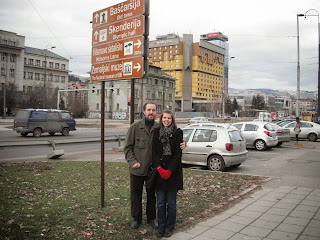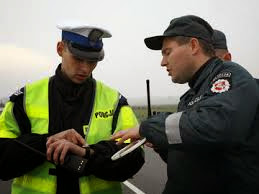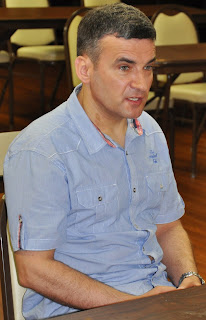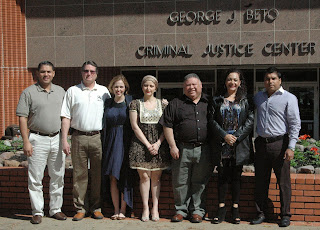Here is a list of publications recently produced by faculty, students and alumni of Sam Houston State University, College of Criminal Justice.
Barnes, J.C., Golden, K., Mancini, C.,
Boutwell, B.B., Beaver, K.M., & Diamond, B. (2014). Marriage and involvement in crime: A consideration of reciprocal effects in a nationally representative sample.
Justice Quarterly, 31(2), 229-256.
Beaver, K.M., Barnes, J.C., &
Boutwell, B.B. (2013). Exploring the relationship between violent behavior and participation in football during adolescence: Findings from a sample of sibling pairs.
Youth and Society. Advance online publication.
Beaver, K.M., Barnes, J.C., &
Boutwell, B.B. (2013). The 2-repeat allele of the MAOA gene confers an increased risk for shooting and stabbing behaviors.
Psychiatric Quarterly. Advance online publication.
Bergseth, K.J., &
Bouffard, J.A. (2013). Examining the impact of restorative justice for various types of juvenile offenders.
International Journal of Offender Therapy and Comparative Criminology, 57(9), 1054-1075.
Boisvert, D., Wright, J. P., Knopik, V., & Vaske, J. (2013). A twin study of sex differences in self-control.
Justice Quarterly, 30, 529-559.
Bouffard, J.A. (2013). The role of sexual arousal and perceived consequences in men’s and women’s decisions to engage in sexual coercion. In J. L. Van Gelder, H. Elffers, D. Reynald & D.S. Nagin (Eds.),
Affect and cognition in criminal decision making (pp. 77-96). Abingdon, Oxford: Routledge.
Bouffard, J., & Miller, H.A. (2014). The role of sexual arousal and overperception of sexual intent within the decision to engage in sexual coercion.
Journal of Interpersonal Violence. Advance online publication.
Bouffard, L.A. (2013). Babies behind bars: A cross-cultural perspective on mother-baby programs. In G. Bruinsma & D.Weisburd (Eds.),
Encyclopedia of Criminology and Criminal Justice. New York: Springer.
Bouffard, L.A., & *Koeppel, M.D.H. (2014). Understanding the potential long-term physical and mental health consequences of early experiences of victimization.
Justice Quarterly, 31(3), 568-587.
Bouffard, L.A.& Sherman, L.S. (2013). Defiance Theory. In G. Bruinsma & David Weisburd (Eds.),
Encyclopedia of Criminology and Criminal Justice. New York: Springer.
Boutwell, B.B, Menard, S., Barnes, J.C., Beaver, K.M.,
Armstrong, T.A., & Boisvert, D. (2013). The role of gene-gene interaction in the prediction of criminal behavior.
Comprehensive Psychiatry, 55(3), 483-488.
Chen, Y. S., **Lai, Y. L., & **Lin, C. Y. (2014). The impact of prison adjustment among women offenders: A Taiwanese perspective.
The Prison Journal, 91(1), 7-29.
Covey, H. C.,
Menard, S., & Franzese, R. J. (2013). Effects of adolescent physical abuse, exposure to neighborhood violence, and witnessing parental violence on adult socioeconomic status.
Child Maltreatment, 18(2), 85-97.
Davis, B., &
Menard, S. (2013). Long term impact of youth sports participation on illegal behavior.
Social Science Journal, 50(1) 34-44.
Decker, S.H.,
Pyrooz, D.C., Sweeten, G., & Moule, R.K. (2014). Validating self-nomination in gang research: Assessing difference in gang embeddedness across non-, current, and former gang members.
Journal of Quantitative Criminology. Advance online publication.
Garner, R. L. (2014). Humor in pedagogy. In S. Attardo (Ed.),
Encyclopedia of humor studies. Thousand Oaks, California: Sage.
Garner, R. (2013). Interpersonal criticism and the clergy.
Journal of Pastoral Care and Counseling, 67(1), 1-14.
Griffin, M. L.,
Pyrooz, D.C., & Decker, S.H. (2013). Surviving and thriving: The growth, influence and administrative control of prison gangs. In J.L. Wood and T.A. Gannon (Eds.),
Crime and crime reduction: The importance of group processes (pp. 137-156). New York: Routledge.
Kalmbach, K.C., &
Garner, R. (2014). Law enforcement and military members: Engaging in the community. In S. Morgillo, L. Miller, B. Moore, & A. Freeman (Eds.),
Behind the badge: A psychological treatment handbook for law enforcement officers. New York: Routledge, Taylor & Francis Group.
Kerrigan, S., *Mott, A., *Jazlau, B, *Ortiz, F., *Perrella, L., *Martin, S., & *Bryand, K. (2014). Designer psychostimulants in urine by Liquid Chromatography–Tandem Mass Spectrometry.
Journal of Forensic Science, 59(1), 175-183.
**Kim, B., Matz, A.K.,
Gerber, J., Beto, D.R., & Lambert, E. (2013). Facilitating police-probation/parole partnerships: An examination of police chiefs’ and sheriffs’ perceptions.
Policing: An International Journal of Police Strategies & Management, 36, 752-767.
Knight, K.E., Menard, S., & *Simmons, S.B. (2013). Intergenerational continuity of substance use.
Substance Use & Misuse, 49, 221‐233.
*Koeppel, M., &
Bouffard, L.A. (2014). Sexual orientation and the effects of Intimate Partner Violence.
Women & Criminal Justice, 4(2), 126-150.
**Lee, J.,
Menard, S., & Bouffard, L.A. (2014). Extending interactional theory: The labeling dimension.
Deviant Behavior, 35(1), 1-19.
**Leechaianan, Y. &
Longmire, D.R. (2013). The use of the death penalty for drug trafficking in the United States, Singapore, Malaysia, Indonesia and Thailand: A comparative legal analysis.
Laws 2(2), 115-149.
**Leechaianan, Y., &
Roth, M.P. (2014). Cases of human trafficking in Texas during 1992 to 2006: A content analysis.
Journal of International Criminal Justice Research, 1.
Matz, A.K., Woo, Y., & **Kim, B. (2014). A meta-analysis of the correlates of turnover intent in criminal justice organizations: Does agency type matter?
Journal of Criminal Justice, 42(3), 233-243.
*Menaker, T.A., &
Franklin, C.A. (2013).When violence is the norm: Sociological explanations for Intimate Partner Violence. In K.M. Beaver, J.C. Barnes, & B.B. Boutwell (Eds.),
On the origins of criminal behavior and criminality: The nurture versus biosocial debate in criminology. Thousand Oaks, CA: Sage Publications.
Menard, S.& Grotpeter, J. K. (2014). Evaluation of bully-proofing your school as an elementary school anti-bullying intervention.
Journal of School Violence, 13(2), 188-209.
Miller, B., & **Morris, R. G. (2014). Virtual peer effects in social learning theory.
Crime & Delinquency. Advance online publication.
Moule, Jr., R. K., Decker, S. H., &
Pyrooz, D.C. (2013) Social capital, the life-course, and gangs. In C. Gibson & M. Krohn (Eds.),
Handbook of life-course criminology (pp. 143-158). New York: Springer.
Moule Jr., R. K.,
Pyrooz, D.C.,& Decker, S.H. (2013). From ‘what the f#@% is a Facebook?’ to ‘Who doesn’t use Facebook?’ The role of criminal lifestyles in the adoption and use of the Internet.
Social Science Research, 42, 1411-1421.
Muftić, L. R. (2013). Securing the border in Bosnia and Herzegovina: An exploratory analysis of the impact of training on officers’ knowledge and experiences related to sex trafficking.
European Journal of Criminal Policy and Research. DOI: 10.1007/s10610-013-9213-7
Muftić, L. R. (2013). Attitudes regarding criminal justice responses to sex trafficking among law enforcement officers in Bosnia and Herzegovina.
Varstvoslovje (Journal of Criminal Justice & Security), 2, 177-189.
Muftić, L. R.& Finn, M. A. (2013). Health outcomes among females trafficked for sex in the United States: A closer look.
Journal of Interpersonal Violence, 28(9), 1858-1883.
Muftić, L. R., & Hunt, D. (2013) Victim precipitation: Further understanding the linkage between victimization and offending in homicide.
Homicide Studies, 17(3), 239-254. DOI: 1088767912461785.
Muftić, L. R., & Collins, S. C. (2013). Gender attitudes and the police in Bosnia and Herzegovina: male officers’ attitudes regarding their female counterparts.
Police Practice & Research: An International Journal. Advance online publication.
Maljević, A., &
Muftić, L. R. (2013). Attitudes towards electronic monitoring: An exploratory analysis among criminal justice students in Bosnia and Herzegovina.
European Journal of Criminal Policy and Research. DOI: 10.1007/s10610-013-9214-6
Muftić, L. R., & Rašić, A. (2013). Beauty & the beast: Gender integration and the police in post-conflict Bosnia and Herzegovina. In M. Fineman & E. Zinsstag (Eds.)
Feminist Perspectives on Transnational Justice (pp. 293-309). Cambridge, U.K.: Intersentia.
**Nolasco, C.A.R.I.,
Vaughn, M.S., & del Carmen, R.V. (2013). Revisiting the choice model of Ponzi and Pyramid schemes: An analysis of case law.
Crime, Law, and Social Change. Advance online publication. DOI 10.1007/s10611-013-9456-8.
Orrick, E. A., & Piquero, A. R. (2013). Were cell phones associated with lower crime in the 1990’s and 2000’s?
Journal of Crime and Justice. Advance online publication.
Pyrooz, D. C. (2013). Gangs, criminal offending, and an inconvenient truth: Considerations for gang prevention and intervention in the lives of youth.
Criminology and Public Policy, 12, 427-436.
Pyrooz, D. C., & Decker, S. H. (2012). Motifs et modalités de sortie d’une bande organisée: Compréhension du processus de retrait d’une bande. In M. Mohammed (Ed.),
Sortir de la délinquance: Théories, enquêtes, perspectives internationales. Paris: La Decouverte.
Pyrooz, D. C., & Ferrer, A. (2013). Theories of gang membership and gang behavior. In J. M. Miller, & R. A. Wright (Eds.),
Encyclopedia of theoretical criminology. New York: Springer.
Pyrooz, D.C., Moule Jr., R.K., & Decker, S.H. (2014). The contribution of gang membership to the victim–offender overlap.
Journal of Research in Crime and Delinquency, 51(3), 315-348.
Randa, R. (2013). The Influence of the cyber-social environment on fear of victimization: Cyberbullying and school.
Security Journal, 26, 331-348.
**Rembert, D.A., &
Henderson, H. (2014). Correctional officer excessive use of force: Civil liability under Title 42 U.S.C 1983.
The Prison Journal. Advance online publication.
Roth, M.P. (2013). Historical overview of transnational crime. In P. Reichel & J. Albanese (Eds),
Handbook of transnational crime and justice (2nd ed., pp. 5-22). Thousand Oaks, CA.: Sage.
Roth, M.P. (2013). Bonnie and Clyde in Texas: The end of the Texas outlaw tradition. In B. A. Glasrud, & H. J. Weiss, Jr. (Eds.)
Tracking the Texas Rangers: The Twentieth Century (pp. 120-132). Denton, TX: University North Texas Press.
**Sarver, M., &
Miller, H.A. (2014). Police chief leadership: Styles and effectiveness.
Policing: An International Journal of Police Strategies & Management, 37(1), 126-143.
*Steinmetz, K. F., & *Chism, K. A. (2013). Police officer expectations of privacy against electronic monitoring in the workplace: An introductory legal analysis.
Journal of Criminal Justice and Law Review, 3(1-2), 67-87.
Vaske, J.,
Boisvert, D., Wright, J. P., & Beaver, K. M. (2013). A longitudinal analysis of the effects of a DRD4 polymorphism on marijuana use.
Psychiatry Research, 210, 247-255.
Vaske, J., Newsome, J., &
Boisvert, D. (2013). The mediating effects of intelligence on the relationship between birth complications and antisocial behaviors.
Infant and Child Development, 22, 235-249.
**Wilson, F.T., &
Henderson, H. (2014). The criminological cultivation of African American municipal police officers: Sambo or sellout.
Race and Justice, 4(1), 45-67.
Zhao, R., Cao, L. &
Zhao, J. (2013). Fear of crime and punitivity among college students in Macau, China. In H. Kury & J. Winterdyk (Eds.),
Fear of crime and punitiveness: Results from international students surveys. Bochum, Germany: Universitaetsverlag Brockmeyer.
Zhao, J., **Tsai, C. F.,
Ren, L.,& **Lai, Y. L. (2014). Public satisfaction with police control of disorder crime: Does the public hold police accountable?
Justice Quarterly, 31(2), 394-420.
Key
Bold: Faculty
*: Doctoral Students
**: Alumni






 Although more limited in scope, physician-assisted suicide legislation in the United States has a sizable history with the practice legal in the states of Oregon, Washington, and Montana. Meanwhile, countries such as Germany and France have had heated political debates about this issue throughout their societies.
Although more limited in scope, physician-assisted suicide legislation in the United States has a sizable history with the practice legal in the states of Oregon, Washington, and Montana. Meanwhile, countries such as Germany and France have had heated political debates about this issue throughout their societies.


 br />Internship Coordinator Dr. Jim Dozier
br />Internship Coordinator Dr. Jim Dozier
 Her duties included protecting LCRA assets, like bridges.
Her duties included protecting LCRA assets, like bridges. Tipton on directed patrol with two LCRA Rangers.
Tipton on directed patrol with two LCRA Rangers.





 The TSA, created in 2001, spent $7.9 billion last year and employed 62,000 employees to protect more than 450 commercial airports, with two-thirds of the budget dedicated to airport screening, Bandow said. He said the agency is more “bureaucracy than safety,” and often makes the news for its poor performance and abuse of civil liberties of airline passengers.
The TSA, created in 2001, spent $7.9 billion last year and employed 62,000 employees to protect more than 450 commercial airports, with two-thirds of the budget dedicated to airport screening, Bandow said. He said the agency is more “bureaucracy than safety,” and often makes the news for its poor performance and abuse of civil liberties of airline passengers.

 The study demonstrates that prenatal environmental experiences may influence future behavioral problems in children, especially in combination with the presence of genetic risk factors. Ultimately, the study presented four key findings:
The study demonstrates that prenatal environmental experiences may influence future behavioral problems in children, especially in combination with the presence of genetic risk factors. Ultimately, the study presented four key findings:
 “While we are not saying that family environments are completely unimportant, environmental experiences encompass far more than just parenting. It is possible, in fact, than other environmental experiences may matter just as much, and perhaps more in some cases, for development than simply what happens inside the home between parents and children.”
“While we are not saying that family environments are completely unimportant, environmental experiences encompass far more than just parenting. It is possible, in fact, than other environmental experiences may matter just as much, and perhaps more in some cases, for development than simply what happens inside the home between parents and children.”


 The Polish National Police are set up in 16 states and a metro area.
The Polish National Police are set up in 16 states and a metro area.












 The Mexican delegation included judges and restorative justice professionals.
The Mexican delegation included judges and restorative justice professionals.


 Students live and learn together
Students live and learn together Students in the program will build strong relationships.
Students in the program will build strong relationships.  Many former students in the program still study together.
Many former students in the program still study together. 

 The study was based on interviews with 621 youth and young adults from five cities, including Cleveland, OH; Fresno, CA; Los Angeles, CA; Phoenix, AZ; and St. Louis, MO. It was funded in part by Google Ideas, a think/do tank that explores the role that technology can play in tackling human challenges, such as violent extremism, illicit networks and fragile states.
The study was based on interviews with 621 youth and young adults from five cities, including Cleveland, OH; Fresno, CA; Los Angeles, CA; Phoenix, AZ; and St. Louis, MO. It was funded in part by Google Ideas, a think/do tank that explores the role that technology can play in tackling human challenges, such as violent extremism, illicit networks and fragile states. In contrast, it is the group process that puts gang members at the cross hairs of offending and victimization. At any given time, 2 percent of youth and young adults in the U.S. are in gangs. In major cities, homicide rates for gang members are 100 times higher than that of the general public.
In contrast, it is the group process that puts gang members at the cross hairs of offending and victimization. At any given time, 2 percent of youth and young adults in the U.S. are in gangs. In major cities, homicide rates for gang members are 100 times higher than that of the general public. The full study, entitled “The Contribution of Gang Membership to the Victim-Offender Overlap” can be found in the Journal of Research in Crime and Delinquency at http://jrc.sagepub.com/content/51/3/315.full.pdf+html
The full study, entitled “The Contribution of Gang Membership to the Victim-Offender Overlap” can be found in the Journal of Research in Crime and Delinquency at http://jrc.sagepub.com/content/51/3/315.full.pdf+html Officers learned to distinguish bones in the human skeleton.
Officers learned to distinguish bones in the human skeleton..jpg)
 During his award presentation at Washington State University, Dr. Zhao shared his research with students. His guest lecture was entitled “Public Attitudes toward the Police: An Enduring Theme with New Frontiers.”
During his award presentation at Washington State University, Dr. Zhao shared his research with students. His guest lecture was entitled “Public Attitudes toward the Police: An Enduring Theme with New Frontiers.” Dr. Zhao suggests these studies can be expanded to provide a clearer picture of public attitudes toward police by adding new dimensions, including geo-mapping and culture.
Dr. Zhao suggests these studies can be expanded to provide a clearer picture of public attitudes toward police by adding new dimensions, including geo-mapping and culture.